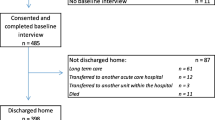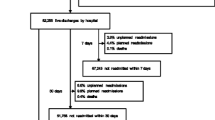Abstract
In older people, revisit to the emergency department (ED) in the short period after discharge is not entirely avoidable, but in a proportion of cases is preventable, and should ideally be minimised. We have previously derived a risk probability nomogram to predict the likelihood of revisit. In this study, we sought to validate the nomogram for use as a general risk stratification tool for use in older people being discharged from ED. We conducted a prospective cohort study, applying the nomogram to consecutive community dwelling discharged patients aged 65 and over. Patients were followed up at 28 days post-discharge to determine whether there had been any unplanned ED revisit in that period. We cross tabulated predicted risk versus revisit rates. In 1143 study subjects, we find the odds of revisit increases progressively with increasing strata of predicted risk, culminating in an OR of 9.7 (95 % CI 4.7–19.9) in the highest risk group. The 28-day revisit rates across strata range from 16 % through 65 %, with the difference between strata being statistically highly significant (p < 0.001). The area under the ROC curve is 0.65. We conclude that the risk nomogram can classify older people discharged from ED into risk strata, and has modest overall predictive value.



Similar content being viewed by others
References
Covinsky KE, Palmer RM, Fortinsky RH, Counsell SR, Stewart AL, Kresevic D, Burant CJ, Landefeld CS (2003) Loss of independence in activities of daily living in older adults hospitalized with medical illnesses: increased vulnerability with age. J Am Geriatr Soc 51(4):451–458
McCusker J, Roberge D, Vadeboncoeur A, Verdon J (2009) Safety of discharge of seniors from the emergency department to the community. Healthc Q 12 Spec No Patient:24–32
Arendts G, Lowthian J (2013) Demography is destiny: an agenda for geriatric emergency medicine in Australasia. Emerg Med Australas 25(3):271–278
Arendts G (2010) Predicting outcome following allied health intervention and discharge of the elderly patient from the emergency department. In: 2010 International Conference on Emergency Medicine (ICEM) Selected Abstracts. Acad Emerg Med 17(11):1258–1262
Arendts G, Fitzhardinge S, Pronk K, Hutton M, Nagree Y, Donaldson M (2013) Derivation of a nomogram to estimate probability of revisit in at-risk older adults discharged from the emergency department. Intern Emerg Med 8(3):249–254
Holman CDAJ, Bass AJ, Rosman DL, Smith MB, Semmens JB, Glasson EJ, Brook EL, Trutwein B, Rouse IL, Watson CR et al (2008) A decade of data linkage in Western Australia: strategic design, applications and benefits of the WA data linkage system. Aust Health Rev 32(4):766–777
Salvi F, Morichi V, Grilli A, Giorgi R, De Tommaso G, Dessi-Fulgheri P (2007) The elderly in the emergency department: a critical review of problems and solutions. Intern Emerg Med 2(4):292–301
Khan SA, Miskelly FG, Platt JS, Bhattachryya BK (1996) Missed diagnoses among elderly patients discharged from an accident and emergency department. J Accid Emerg Med 13(4):256–257
Rodriguez-Molinero A, Lopez-Dieguez M, Tabuenca AI, de la Cruz JJ, Banegas JR (2006) Functional assessment of older patients in the emergency department: comparison between standard instruments, medical records and physicians’ perceptions. BMC Geriatr 6:13
Rodriguez-Molinero A, Lopez-Dieguez M, Tabuenca AI, de la Cruz JJ, Banegas JR (2010) Physicians’ impression on the elders’ functionality influences decision making for emergency care. Am J Emerg Med 28(7):757–765
Brazil K, Bolton C, Ulrichsen D, Knott C (1998) Substituting home care for hospitalization: the role of a quick response service for the elderly. J Community Health 23(1):29–43
Arendts G, Fitzhardinghe S, Pronk K, Donaldson M, Hutton M, Nagree Y (2012) The impact of early emergency department allied health intervention on admission rates in older people: a non-randomized clinical study. BMC Geriatr 12:8
Moss JE, Flower CL, Houghton LM, Moss DL, Nielsen DA, Taylor DM (2002) A multidisciplinary Care Coordination Team improves emergency department discharge planning practice. Med J Aust 177(8):435–439
Ngian VJJ, Ong BS, O’Rourke F, Nguyen HV, Chan DKY (2008) Review of a rapid geriatric medical assessment model based in emergency department. Age Ageing 37(6):696–699
Moons P, De Ridder K, Geyskens K, Sabbe M, Braes T, Flamaing J, Milisen K (2007) Screening for risk of readmission of patients aged 65 years and above after discharge from the emergency department: predictive value of four instruments. Eur J Emerg Med 14(6):315–323
McCusker J, Bellavance F, Cardin S, Trepanier S, Verdon J, Ardman O (1999) Detection of older people at increased risk of adverse health outcomes after an emergency visit: the ISAR screening tool. J Am Geriatr Soc 47(10):1229–1237
Meldon SW, Mion LC, Palmer RM, Drew BL, Connor JT, Lewicki LJ, Bass DM, Emerman CL (2003) A brief risk-stratification tool to predict repeat emergency department visits and hospitalizations in older patients discharged from the emergency department. Acad Emerg Med 10(3):224–232
Marshall JC (2014) The PIRO (predisposition, insult, response, organ dysfunction) model: toward a staging system for acute illness. Virulence 5(1):27–35
Salvi F, Morichi V, Lorenzetti B, Rossi L, Spazzafumo L, Luzi R, De Tommaso G, Lattanzio F (2012) Risk stratification of older patients in the emergency department: comparison between the Identification of Seniors at Risk and Triage Risk Screening Tool. Rejuvenation Res 15(3):288–294
LaMantia MA, Platts-Mills TF, Biese K, Khandelwal C, Forbach C, Cairns CB, Busby-Whitehead J, Kizer JS (2010) Predicting hospital admission and returns to the emergency department for elderly patients. Acad Emerg Med 17(3):252–259
Arendts G, Fitzhardinge S, Pronk K, Hutton M (2013) Outcomes in older patients requiring comprehensive allied health care prior to discharge from the emergency department. Emerg Med Australas 25(2):127–131
Acknowledgments
This research was funded by a grant from the State health Research Advisory Council of Western Australia.
Conflict of interest
Authors RJ, KB, SD and MH are employees of the Western Australian State Government that funded the research through the State Health Research Advisory Council. All other authors declare they have no conflicts of interest.
Statement of human and animal rights
All procedures performed in studies involving human participants were in accordance with the ethical standards of the institutional and/or national research committee and with the 1964 Helsinki declaration and its later amendments or comparable ethical standards.
Informed consent
Informed consent was obtained from all individual participants included in the study.
Author information
Authors and Affiliations
Corresponding author
Rights and permissions
About this article
Cite this article
Arendts, G., Etherton-Beer, C., Jones, R. et al. Use of a risk nomogram to predict emergency department reattendance in older people after discharge: a validation study. Intern Emerg Med 10, 481–487 (2015). https://doi.org/10.1007/s11739-015-1219-3
Received:
Accepted:
Published:
Issue Date:
DOI: https://doi.org/10.1007/s11739-015-1219-3




